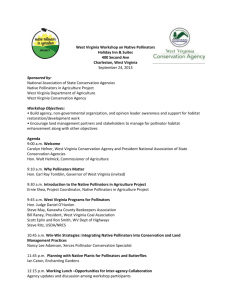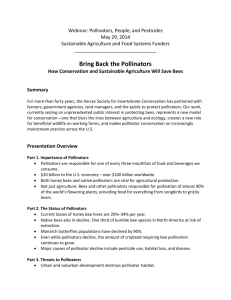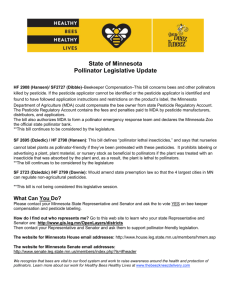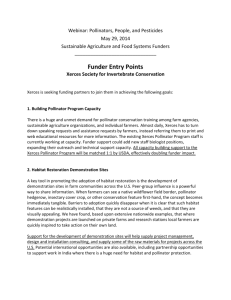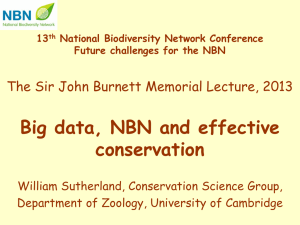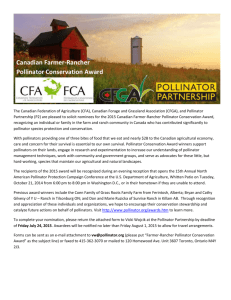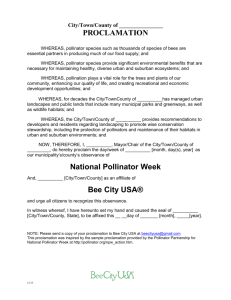clicking here. - Bumblebee Conservation Trust
advertisement
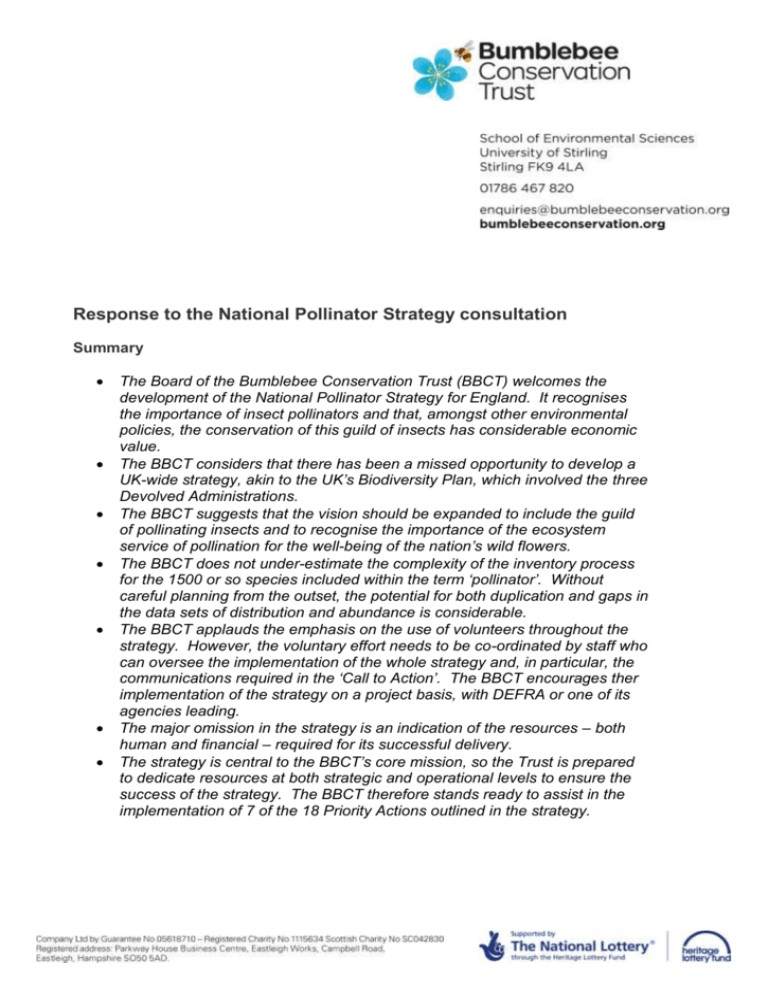
Response to the National Pollinator Strategy consultation Summary The Board of the Bumblebee Conservation Trust (BBCT) welcomes the development of the National Pollinator Strategy for England. It recognises the importance of insect pollinators and that, amongst other environmental policies, the conservation of this guild of insects has considerable economic value. The BBCT considers that there has been a missed opportunity to develop a UK-wide strategy, akin to the UK’s Biodiversity Plan, which involved the three Devolved Administrations. The BBCT suggests that the vision should be expanded to include the guild of pollinating insects and to recognise the importance of the ecosystem service of pollination for the well-being of the nation’s wild flowers. The BBCT does not under-estimate the complexity of the inventory process for the 1500 or so species included within the term ‘pollinator’. Without careful planning from the outset, the potential for both duplication and gaps in the data sets of distribution and abundance is considerable. The BBCT applauds the emphasis on the use of volunteers throughout the strategy. However, the voluntary effort needs to be co-ordinated by staff who can oversee the implementation of the whole strategy and, in particular, the communications required in the ‘Call to Action’. The BBCT encourages ther implementation of the strategy on a project basis, with DEFRA or one of its agencies leading. The major omission in the strategy is an indication of the resources – both human and financial – required for its successful delivery. The strategy is central to the BBCT’s core mission, so the Trust is prepared to dedicate resources at both strategic and operational levels to ensure the success of the strategy. The BBCT therefore stands ready to assist in the implementation of 7 of the 18 Priority Actions outlined in the strategy. Introduction The Board of the Bumblebee Conservation Trust (BBCT) welcomes the consultation on the National Pollinator Strategy for England. It aims to fill important gaps in England’s protection of pollinator species, conservation of the ecosystem services which they provide, and our understanding of the ecology of bumblebees and other pollinator species. The BBCT is keen to continue to play a key role in the refinement of the strategy through the consultation process and in support of the priority actions. . The BBCT was established in 2006 to address the decline of the UK’s bumblebees. There are 25 bumblebee species native to the UK (approximately 10% of the world’s species), although two species become nationally extinct during the twentieth century (Bombus cullumanus in 1941 and B. subterraneus in 1988), although this latter species is currently the subject of a reintroduction project. Many of the remaining species have declined in their geographical range and abundance, including two species listed as ‘vulnerable’ on the IUCN’s 2013 European regional assessment. The BBCT is addressing these concerns with a mixture of direct conservation measures and advice (to businesses, farmers & landowners, and the general public), scientific monitoring (the BBCT run the only British standardised survey of bumblebee abundance and distribution), and public outreach (aimed at raising public awareness of, and engagement with, bumblebee species). As stated in the BBCT’s Strategic Plan, 2014 – 2019), “The BBCT’s vision is to ensure that our communities and countryside will be rich in bumblebees and colourful wildflowers, supporting a diversity of wildlife and habitats for everyone to enjoy”. “The BBCT’s strategic aims are to: support the conservation of all bumblebees, rare or abundant; raise awareness and increase understanding about bumblebees and the social, economic, environmental and cultural benefits which they and other pollinators provide; and ensure that the BBCT is sustainable, fit for purpose, and able to respond quickly to challenges and change”. Question 4. Do you have any comments on the vision and aims for pollinators (in Chapter 2)? The BBCT would prefer to see the diversity of the pollinator guild and wild flowers explicitly mentioned in the vision. Perhaps the vision could be: ‘Our vision is to see the diversity of pollinators thrive, providing essential pollination services and benefits for food production, healthy wild flower populations, the wider environment and everyone’. Whilst the BBCT agrees that, in paragraph 18, there is firm evidence of the decline in Lepidoptera populations, there is considerable evidence in geographical distributional decline for many species within the pollinator guild. The BBCT’s BeeWalk survey scheme has also been established to collect abundance and distribution data on bumblebees in a manner analogous to Butterfly Conservation’s Butterfly Monitoring Scheme. The BBCT would be pleased to see its BeeWalk project forming an integral part of the overall inventory exercise for the 25 Bombus species. The building of partnerships and the input from volunteers is essential. The BBCT therefore considers that paragraph 19 should be more inclusive, encompassing the inputs of local authorities, NGOs and volunteers alongside environmental groups and businesses Questions 5 and 6. Have we given a fair summary of main areas of concern and the available evidence (in Annex 1)? Annex 1 is a good summary of the main areas of concern for pollinators and the available evidence. However, the BBCT has 4 points to raise. Paragraph 7, the first bullet point is incorrect. Two species became extinct during the 20th century (Bombus cullumanus in 1941 and B. subterraneus in 1988), and during the 21st century one has colonised naturally (B. hypnorum in 2001). B. subterraneus is currently being re-introduced. The great yellow bumblebee, B. distinguendis, became extinct in England during the past half-century, but remains a UK species as there are populations in Scotland. Whilst the BBCT accepts the generalities mentioned in the second bullet point of paragraph 7, very considerable care needs to be exercised in distinguishing between species richness, species diversity, species abundance and species distribution. This is exemplified by Carvalheiro et al (2013), who examined species richness, not abundance or diversity, and recognised that this placed severe limitations on the interpretation of the historical data. Paragraph 12 notes that the provision of flowers boosts the abundance of insects visiting those pollen and nectar sources, but that we have little understanding of whether populations of these insects are benefiting. Further research is needed into how agri-environment schemes can be designed for the greatest benefit of pollinators. Paragraph 15 does not appear to take into account several recent semi-field experiments on the effects of insecticides on bumblebees (e.g. Whitehorn et al. 2012 in Science, Gill et al. 2012 in Nature, or Laycock et al. 2012 in Ecotoxicology). Whilst the pesticide manufacturers are probably best placed to evaluate the effects of pesticides on pollinators, however, given the intense public interest in this subject, the entire process (the questions posed, the results, and publication of interpretations of the results) should be completely transparent. Several research groups are currently working on the effects of pesticides on pollinators (for example at the Universities of Exeter, Sussex and London Royal Holloway) and they should be involved. Questions 7 and 8. Do you have any suggestions on the best way to communicate the ‘Call to Action’ (once agreed) to many different audiences (in Chapter 3)? The aim of the ‘Call to Action’ is to engage with a large and diverse audience. Hence the BBCT recommends that a communication specialist be engaged to develop and co-ordinate a coherent plan involving a variety of media, including print, TV, radio and social media. The BBCT urges that the core messages use a language which the public can relate to; that a sense of urgency is given to encourage people to take action now; and that messages are positive (i.e. they encourage rather than tell). Questions 9 and 10. Do you agree with the priority actions summarised in Chapter 3? The BBCT broadly agree with these Actions, and anticipates that there will be opportunities for the involvement of the Trust. The BBCT recommends that the following 8 points be taken into account. Priority Actions 3 & 4: Advice will be required for all forms of land management, not just on farms. In upland areas, for example, heather can form an important component of the diet of pollinators. The BBCT are heavily involved with advising land managers on appropriate management practices for bumblebees. The BBCT has a series of factsheets on managing different kinds of land – see http://bumblebeeconservation.org/get-involved/managing-your-land/. Priority Action 11. The BBCT recommends that agri-environment schemes be included in the list of ‘current and emerging initiatives’. Priority Action 12. The BBCT is enthusiastic about the establishment of a pollinator award scheme, and would wish to be involved in an appropriate way. Priority Action 14. Any voluntary quality standard on native wildflower seeds would be welcomed. However, it would be preferable for it to be developed in partnership with the trade, especially locally, rather than being imposed from above. Paragraph 53. Monitoring of pests and diseases is not mentioned in the priority actions. Whilst the BBCT supports the evidence requirements and research mentioned in this paragraph, monitoring of imported bumblebees might be helpful in identifying the chance introduction of novel pests and diseases to naïve wild bee populations. Paragraph 56. The BBCT already provides considerable resources for gardeners – see http://bumblebeeconservation.org/get-involved/gardening-for-bees/. The BBCT also has a web tool, BeeKind, to evaluate an area’s suitability for bees and other pollinators, to identify any gaps in the provision of pollinator-friendly resources, and to suggest the most effective and parsimonious ways to improve the suitability. Policy Action 17. It is difficult to accept that ‘members of the public’ will be able to lead on a priority action. Co-ordination will be essential to maximise the efforts of the voluntary sector. One or more dedicated staff members would be required to co-ordinate this action. The BBCT encourages implementation of the strategy on a project basis, with DEFRA or one of its agencies (e.g. Natural England, FERA) leading. Overall, the BBCT recommends that care be taken that the focus is not wholly on the provision of pollen and nectar resources. Adult pollinators require flowers for food, but their other life-history stages are likely to have different requirements. For example, the juvenile stages of most Lepidoptera, Diptera & Coleoptera eat leaves or are predatory. All species of pollinators have yet other ecological requirements, such as for overwintering sites, which must be in place for a healthy population to survive. Questions 11 and 12. Have we identified the right priority areas for future research and monitoring (in Chapter 3)? The BBCT is broadly in agreement with the outlined priority areas for research and monitoring. The use of volunteers, and agreement on what to monitor, are essential ingredients in achieving the aims of this section. The Trust has five particular comments to make. The use of the words “[important] insect pollinators” begs the question as to what is actually important, especially as research has shown that soft fruit sets better when the flowers have been pollinated by several species. Perhaps what needs to be attempted is to find a series of ‘indicator insect pollinators’ so that the results of monitoring one indicator species could be taken to represent a guild of species. The BBCT strongly supports item 4 in Table 1. Taxonomic expertise is important in any monitoring scheme; the subsequent biological records, which form the foundation of evidence-based conservation and ecology, must be accurate. The Trust welcomes the idea of taxonomic studentships to ensure succession, and promote lesser-studied groups, as mentioned in Annex 4. The BBCT welcomes the considerable reliance on citizen science to support this strategy (point 5 in Table 1). Britain has a very comprehensive (taxonomically and geographically) suite of biological-recording schemes, but the participation of volunteer recorders should never be taken for granted and it is excellent that their contribution is recognised. It is important to understand that 1500 or more very diverse species are included within the term ‘pollinator’ (bees, wasps, flies (particularly hoverflies), beetles, butterflies and moths). Each is an independent species with a different ecology and with different life-history requirements. The ecology of many of these species is either not well known or unknown. Monitoring, even of a small set of indicator species, presents a huge challenge, but to have its greatest influence and accuracy, effective data sharing is essential. The National Biodiversity Network was set up for this express purpose and the BBCT recommends that the NBN must be at the heart of the data-sharing operation. Question 13. How could you contribute further to priority actions? This strategy is central to the BBCT’s core mission, so the Trust is prepared to dedicate resources at both strategic and operational levels to ensure the success of the strategy. Therefore the BBCT can actively support and contribute to seven of the 18 priority actions, in the following ways: Priority action one BBCT will assist in creating a ‘Call to Action’ package. It already has an established, well received and well used suite of advice materials designed for landowners and the general public – see http://bumblebeeconservation.org/getinvolved. Advice covers wildflower meadows, pastures and grasslands; wildflower seed; hedges and edges; field margins; traditional orchards; brownfield and industrial sites; and managing quarries. BBCT also has guidance for gardeners, including the web tool Beekind – see http://beekind.bumblebeeconservation.org/. Since launching in 2012, Beekind has been used by over 30,000 people interested in improving their garden for bumblebees and other pollinators. Priority action three One of BBCT’s primary charitable activities is the provision of advice to landowners in order to create habitat for bumblebees and other pollinating insects. As the Trust moves into the implementation of its new 5 year strategic plan the intention is to work with landowners across the UK to ensure at least 5,000 hectares of high quality land is secured for pollinators. Priority action four The BBCT has extensive experience in this area, engaging landowners in the creation of habitat for bumblebees and other pollinating insects. In November 2013 the Trust held a conference at the Royal Holloway, University of London, aimed at landowners. We were overwhelmed by the interest and had a waiting list the same size as the number attending. The BBCT plans to hold similar conferences across the UK over the next five years. The BBCT works closely with the CFE to run pollinator events on farms. The Trust is also engaged in the work of LEAF, and in particular the Open Farm Sunday events which run annually each June. The Trust intends to use these events as a platform to promote the importance of bumblebees and other pollinating insects, and to provide members of the public with opportunities for participating in our bumblebee-recording projects BeeWalk and BeeWatch Priority Action eight The BBCT has developed an information pack for local authorities. In line with the Trust’s new strategic plan the aim is to work with at least 40 local authorities over the next five years, including conferences, workshops, and the provision of training and advice. The Trust is currently developing a landscape-scale project, along the Kent and East Sussex coastline, which aims to create new habitat for bumblebees and other pollinating insects. In March 2014 the BBCT signed an MOU with the Ministry of Justice, one of the UK’s largest landowners, to provide advice and to identify pollinating insects as part of BeeWalk. The BBCT has also signed similar MOUs with the Mineral Planning Authority and the Solar Trade Association. Priority Action twelve The BBCT would wish to be considered as a potential partner in the proposed ‘pollinator best practice awards’. With a growing and enthusiastic membership, we see this as an excellent platform to test ideas and develop a series of award schemes which genuinely inspire action for bumblebees and other pollinators. Priority Action seventeen The Trust sees the encouragement of members of the public as a core activity. The BBCT is seven years old and has about 8,000 members, with an outstanding 410% increase in unique visitors to its website over one year (48,000 during MaySeptember 2012, rising to 197,000 in the same period in 2013). Since early 2012 the BBCT’s staff and trained volunteers have given 394 talks, walks and engagement in events. Priority action eighteen A number of scientists specialising in pollination services, entomology and bumblebees, have expressed an interest in BBCT’s suitability to establish a system for improving knowledge sharing between scientists, conservation practitioners and NGOs. The Trust would be very keen to develop this in 2015 if funding could be sought to facilitate a conference which translates the work of the Insect Pollinator Initiative into practical actions and best practice. Question 14. We have asked a number of specific questions. If you would like to provide any comments on related issues which we have not specifically addressed, please use the space below to report them. The BBCT has two general comments to make. First, the publication of this ‘National Pollinator Strategy’ is a missed opportunity. To be truly national, the three Devolved Administrations could have been involved in a manner akin to the UK’s Biodiversity Plan, which has separate implementation in the four countries of the UK. This is unfortunate because insects do not respect borders. Several rarer species (including the only two British bumblebee species to be listed as ‘vulnerable’ on the IUCN’s 2013 European risk assessment – B. muscorum and B. distinguendis) are either predominantly or only in Scotland. Second, the strategy makes no provision for the financial resources required for its implementation. This is a serious shortcoming for several reasons. Primarily, to be successful a project of this size and complexity will need a project director with leadership from DEFRA or one of its agencies (e.g. Natural England or FERA) in order both to guide it and to ensure that the 18 priority actions are treated as priorities. It will also require dedicated communications staff to ensure that the ‘Call to Action’ really results in actions. As identified above, the Bumblebee Conservation Trust is committed to assist in implementation of seven of these actions.

